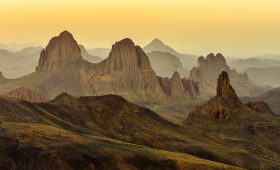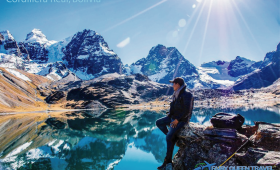Exploring Talampaya National Park
Talampaya National Park, located in Argentina’s La Rioja Province, offers a unique glimpse into the geological and ecological wonders of the High Monte ecoregion. Spanning 2,150 square kilometers at an altitude of 1,500 meters, the park is a sanctuary for both natural beauty and historical significance. It features dramatic landscapes shaped by erosion, with towering red sandstone cliffs and deep canyons.
Geological and Historical Significance
The park’s landscape is a testament to millions of years of geological activity. The Talampaya gorge, with its rock formations reaching up to 143 meters high, is a highlight. The area also holds archaeological importance, with remnants of indigenous settlements, including petroglyphs at Puerta del Cañón. These elements make Talampaya a fascinating destination for those interested in Earth’s ancient history.
Flora and Fauna
Talampaya is home to diverse flora and fauna typical of the mountain biome. Visitors might spot guanacos, hares, maras, foxes, and the majestic Andean condor. The park also features a botanical garden showcasing local plant species at the canyon’s narrowest point. This biodiversity adds another layer of interest for nature enthusiasts.
Best Time to Visit
For a comfortable visit, plan your trip during spring (September to November) or autumn (March to May). These seasons offer mild temperatures ranging from 20 to 25 degrees Celsius. Summer can be intensely hot, so if visiting then, bring sunscreen, a hat, and plenty of water.
Getting There
Talampaya National Park is about 217 kilometers from La Rioja city. Driving is the most convenient option. Take Route 76 towards Villa Unión, then follow signs to the park entrance. The drive takes around three hours and offers scenic views. Alternatively, buses run from La Rioja to Villa Unión, where you can hire a local guide to reach the park.
Exploring the Park
Once at Talampaya, the only way to explore is through guided tours, as private vehicles are not permitted inside. These tours, led by knowledgeable guides, provide insights into the park’s geology, history, and wildlife. They ensure you experience the park’s highlights safely and informatively.
Key Facts
- Located in La Rioja Province, Argentina.
- Covers 2,150 square kilometers at 1,500 meters altitude.
- Features include red rock formations, deep canyons, and archaeological sites.
- Home to diverse plant and animal species, including guanacos and condors.
- Best visited in spring or autumn for mild weather.
- Accessible by car or bus from La Rioja city.
- Guided tours are required for park exploration.



